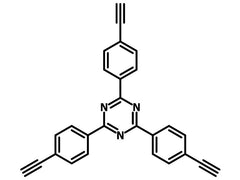2,4,6-Tris(4-ethynylphenyl)-1,3,5-triazine
CAS Number 425629-22-7
Chemistry Building Blocks, COF Ligands, Materials, Porous Organic FrameworksCovalent Organic Frameworks (COFs) Triazine Ligand
An ethynyl ligand linker for COFs in application of carbon dioxide and hydrogen adsorption, aggregation-induced electrochemiluminescence, photocatalyst and sensors
Specifications | MSDS | Literature and Reviews
2,4,6-Tris(4-ethynylphenyl)-1,3,5-triazine (TEPT), CAS number 425629-22-7, featuring a nitrogen rich electron deficient triazine core with three 4-ethynylphenyl side arms. The ethynyl functional groups extend the structure by forming covalent organic frameworks (COFs) via Sonogashira–Hagihara cross-coupling reaction, or by click polymerization reaction with azides to form microporous organic polymers.
Obtained from 2,4,6-tris(4-ethynylphenyl)-1,3,5-triazine unit and aromatic azide linkers by click polymerization reaction, microporous organic polymer CMOP-1 exhibited a Brunauer–Emmett–Teller (BET) surface area of 431 m2·g−1 and a narrow pore size distribution under 1.2 nm. CMOP-1 demonstrated a superior CO2 uptake level of 1.85 mmol·g−1 at 273 K/1.0 bar, H2 uptake of up to 2.94 mmol·g−1 at 77 K/1.0 bar, and I2 vapor adsorption load of 160 wt.%, owing to the rich nitrogen content.
MOF and COF ligands
Ethyne ligand for cross-linked COF networks
Worldwide shipping
Quick and reliable shipping
High purity
>98% High purity
Facile reactions
Readily for click reaction and Sonogashira reaction
General Information
| CAS Number | 425629-22-7 |
|---|---|
| Chemical Formula | C27H15N3 |
| Full Name | 2,4,6-Tris(4-ethynylphenyl)-1,3,5-triazine |
| Molecular Weight | 381.43 g/mol |
| Synonyms | TEPT |
| Classification / Family | Triazine, COF ligands |
Chemical Structure

Product Details
| Purity | >98% |
|---|---|
| Melting Point | N/A |
| Appearance | Yellow to orange powder/crystals |
MSDS Documentation
2,4,6-Tris(4-ethynylphenyl)-1,3,5-triazine MSDS Sheet
Literature and Reviews
-
Synthesis of Nitrogen-Rich Polymers by Click Polymerization Reaction and Gas Sorption Property, Molecules, J. Song et al., 23, 1732 (2018); DOI:10.3390/molecules23071732.
-
Tetraphenylenthene-Based Conjugated Microporous Polymer for Aggregation-Induced Electrochemiluminescence, L. Cui et al., ACS Appl. Mater. Interfaces, 12 (7), 7966–7973 (2020); DOI: 10.1021/acsami.9b21943.
-
Twinned Growth of Metal-Free, Triazine-Based Photocatalyst Films as Mixed-Dimensional (2D/3D) van der Waals Heterostructures, D. Schwarz et al., Adv. Mater., 29 (40), 1703399 (2017); DOI: 10.1002/adma.201703399.
